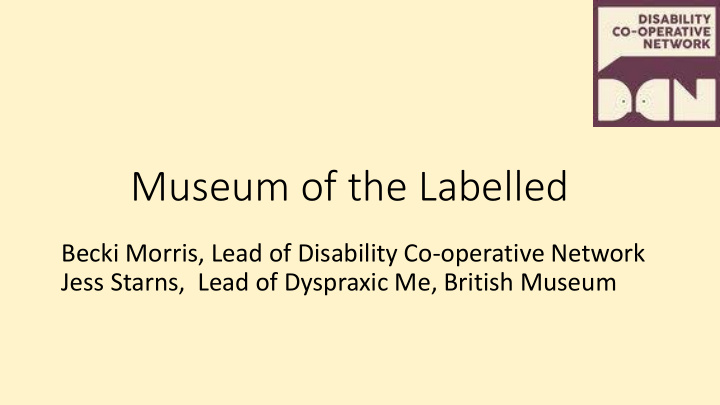



Museum of the Labelled Becki Morris, Lead of Disability Co-operative Network Jess Starns, Lead of Dyspraxic Me, British Museum
Becki Morris, Lead of DCN, Board Membership of DAN/LAB for British Dyslexia Association Jess Starns, Lead of Dyspraxic Me, Youth Volunteer Co-ordinator for British Museum
What is Museum of the Labelled? • Neurodiversity history is currently dispersed, with small collections across many museums and archives. • Museum of the Labelled focuses on finding neurodiverse museum objects in collections. • To start conversation with museums and collections to share their neurodiverse objects. • Discovering neurodiverse history and highlight hidden stories.
What is neurodiversity?
Timeline • 1896: BMJ article ‘Congenital Word Blindness’ about 14 year old Percy • 1935: Orton-Gillingham use the label ‘Dyspraxia’ • 1962: National Autistic Society started by a group of parents
What do you have in your stores that tell the history of neurodiversity?
Neurodiversity and Society The approximate proportions in the population are: • Dyslexia = approx 10% (Source, BDA) (255,000) • Dyspraxia = approx 10% (Source, Dyspraxia Foundation) • ADHD = approx 5% (Source, AADD-UK) • Autism Spectrum = approx 1% (Source, NAS) Note: It was thought more boys than girls affected for all the above, but researchers now believe girls may cope in different ways and therefore ‘slip through the net’.
Neurodiversity in the workplace
Neurodiversity in the workplace • 2013: Multinational software firm 'SAP' advertise specifically for people on the autism spectrum • 2016: Project CAPE launched at the BBC for increasing recruitment and retention of neurodiverse people in the workforce • 2016: Forbes publish the benefits of neurodiverse people in the workforce
Neurodiversity in the workplace • Research and media shows changing attitudes towards neurodiversity • Networks across the country • Difficulties with attitudinal discrimination (Source: WAC AchieveAbility) • Financial barriers to diagnosis • Barriers to Recruitment and Retention
Words
Objects and archives you may have in your stores
Objects and archives you may have in your stores
Future plans for Museum of the Labelled How can you use art to interpret challenging museum objects with a close connection to the participant’s personal experiences?
Future plans for Museum of the Labelled • Why societies need to label neurological difference and the changing labels which have evolved to do this. • Is neurodiversity a disability or is there a neurodiverse-neurotypical spectrum? • How can we create new accessible art works?
Future plans for Museum of the Labelled Participants will: a) learn about neurodiversity history through exploring archives and museum objects b) reflect on their own personal experiences, in comparison to objects and archives c) use this as a catalyst to create new accessible art works.
Future plans for Museum of the Labelled The aim of the workshops will: • Allow participants to understand themselves Give them an opportunity to be involved with a creative project • Develop a sense of belonging and improved wellbeing. • The project will help to break down barriers, stereotypes and give the participants confidence and self-awareness.
Becki Morris Disability Co-operative Network Twitter: @museumDCN Email: info@musedcn.org.uk Jess Starns Dyspraxic Me/Museum of the Labelled Twitter @DyspraxicMe Email dyspraxicme@gmail.com
Recommend
More recommend